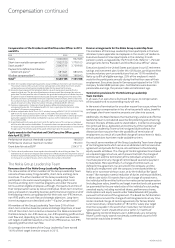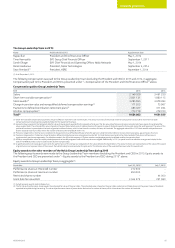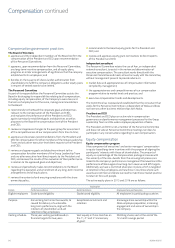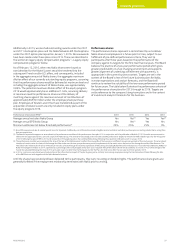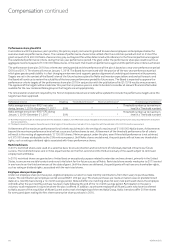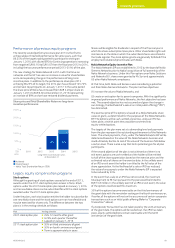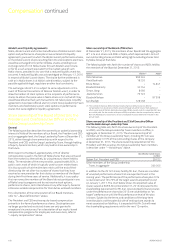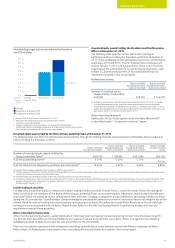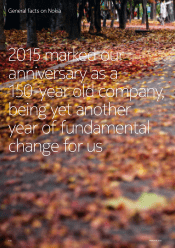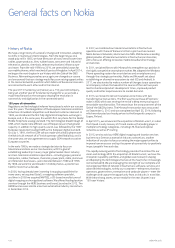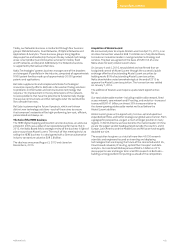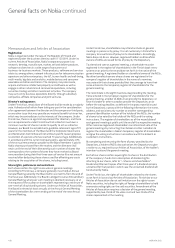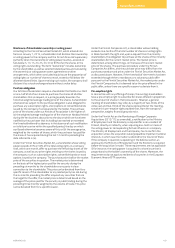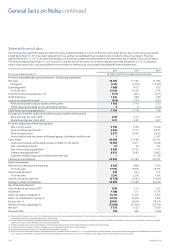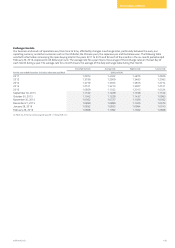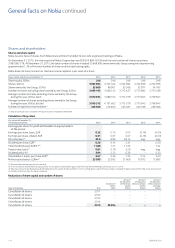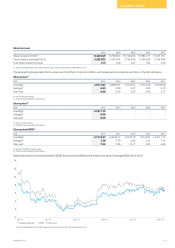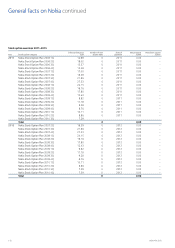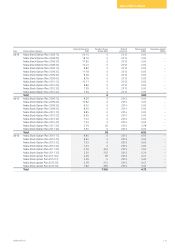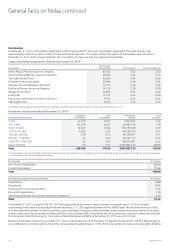Nokia 2015 Annual Report Download - page 106
Download and view the complete annual report
Please find page 106 of the 2015 Nokia annual report below. You can navigate through the pages in the report by either clicking on the pages listed below, or by using the keyword search tool below to find specific information within the annual report.104 NOKIA IN 2015
History of Nokia
We have a long history of successful change and innovation, adapting
to shifts in markets and technologies. From the beginning as one
woodpulp mill in 1865, we have been part of many sectors over time:
cables, paper products, tires, rubber boots, consumer and industrial
electronics, plastics, chemicals, telecommunications infrastructure
and more. From the mid-1990s to 2014, we were widely known for
ourmobile phones, which reached all parts of the globe. In April 2014,
we began the next chapter in our history with the Sale of the D&S
Business. Reinventing ourselves once again, we changed our course
and announced that our strategy would focus on seizing opportunities
in the connected world, a world in which billions of devices and sensors
are connected to each other and to the internet.
The year 2015 marked our anniversary as a 150-year old company,
being yet another year of fundamental change for us as we took a
major step forward as the company shaping the revolution in
connectivity and digitization in the connected world.
150 years of reinvention
Regulatory and technological reforms have played a role in our success
over the years. The deregulation of the European telecommunications
industries stimulated competition and boosted customer demand. In
1982, we introduced the rst fully digital local telephone exchange in
Europe, and, in the same year, the world’s rst car phone for the Nordic
Mobile Telephone analog standard. The technological breakthrough of
GSM, which made more ecient use of frequencies and had greater
capacity, in addition to high-quality sound, was followed by the 1987
European resolution to adopt GSM as the European digital standard.
On July 1, 1991, the rst GSM call was made with a Nokia phone over
the Nokia-built network of a Finnish operator called Radiolinja, and in
the same year, we won agreements to supply GSM networks to other
European countries.
In the early 1990s, we made a strategic decision to focus on
telecommunications as our core business, with the goal of
establishingleadership in every major global market. Basic industry
and non-telecommunications operations—including paper, personal
computers, rubber, footwear, chemicals, power plant, cable, aluminum
and television businesses—were divested between 1989 and 1996.
By1998, we were the world leader in mobile phones, a position we
held for more than a decade.
In 2006, having already been investing in mapping capabilities for
many years, we acquired Gate5, a mapping software specialist,
andthen in 2008 we acquired NAVTEQ, a US-based manufacturer of
digital mapping and navigational software. We oered leading location
services through the HERE business and brand, launched in 2012. The
HERE business was sold to a German automotive industry consortium
in December 2015.
General facts on Nokia
In 2007, we combined our telecommunications infrastructure
operations with those of Siemens to form a joint venture named
NokiaSiemens Networks, also known has NSN. NSN became a leading
global provider of telecommunications infrastructure and services,
with a focus on oering innovative mobile broadband technology
andservices.
In 2011, we joined forces with Microsoft to strengthen our position in
the highly competitive smartphone market. We adopted the Windows
Phone operating system for smart devices and smartphones and,
through the strategic partnership, Nokia and Microsoft set about
establishing an alternative ecosystem to rival iOS and Android. In
2011, we also started to make a number of changes to our operations
and company culture that would in the course of the next two years
lead to shortened product development times, improved product
quality and better responsiveness to market demand.
In 2013, we moved to reinvent ourselves once more, with two
transformative transactions. The rst was the purchase of Siemens’
stake in NSN, which was nearing the end of a deep restructuring and
remarkable transformation. The second was the announcement of the
Sale of the D&S Business. The Microsoft transaction was announced
on September 3, 2013 and was completed on April 25, 2014, following
which we relocated our headquarters to the Karaportti campus in
Espoo, Finland.
In April 2015, we announced the acquisition of Alcatel Lucent, in a deal
that closed in early January 2016 and made us the leading player in
multiple technology categories, including LTE, xed and optical
networks as well as IP routing.
In 2015, we also sold our HERE digital mapping and location services
business to a German automotive industry consortium, another
indication of our plan to focus on seizing the major opportunities to
improve how we access and tap the power of connectivity to positively
impact people’s lives each day.
The rapidly evolving world of technology provides the context for our
vision and strategy. With the acquisition of Alcatel Lucent, we have the
innovation capability, portfolio, and global scale to lead in shaping
anddeploying the technologies that are at the heart of an increasingly
connected world. We are leveraging the strength of our complete and
converged portfolio of network infrastructure, software, services and
advanced technologies, to help our customers—telecommunications
operators, governments, enterprises and webscale players—meet the
challenges and capture the opportunity from an industry in transition.
With these strong assets, we are ready for the next chapter in our
150-year history.


